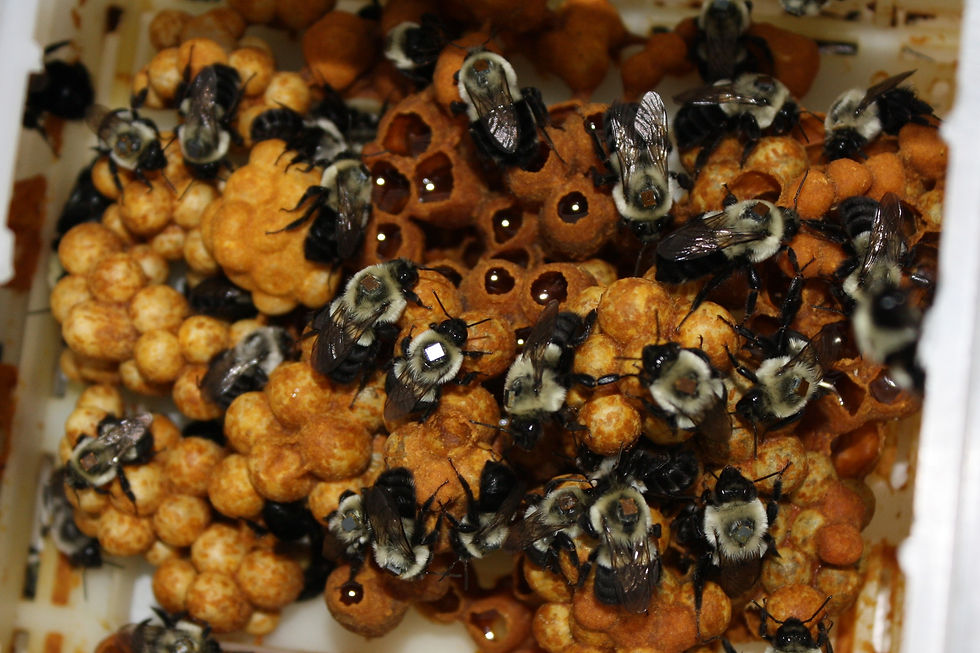BUMBLE BEES POLLINATING A GREENHOUSE
- DIY GABL

- Jun 18, 2018
- 3 min read
Greenhouses are amazing, but plants still need to be pollinated. Bumblebees are an ideal partner with greenhouses for pollination

Greenhouse produce growers are finding that the demand for high-quality fruits, vegetables, and herbs year-round is requiring they yield more to keep up. Enter natural pollination, the process of using bees to pollinate fruits and vegetables. Using bumblebees to pollinate plants inside the greenhouse is one way to improve crop quality, increase yield, and reduce labor.

Here’s what growers need to know before handling hives.
The Pros
Bees certainly have their benefits. According to Ryan Hill, Sales Manager at Koppert Biological Systems, a bumblebee producer and the brand behind Natupol, Tripol, and Natufly, the biggest advantage is that bee pollination results in better fruit.
“If someone is looking to increase their yield and grow more fruit, they should consider natural pollination,” he says. “Certain crops need to be pollinated to produce fruit. If not, the fruit will be misshapen, odd, or the plant won’t produce fruit at all.”
Another advantage to bee pollination is that it reduces an operation’s reliance on human workers. Paul Koole, Technical Team Coordinator North America at Biobest, a commercial bumblebee producer since 1987 with rearing facilities around the world, says the labor savings can be considerable. He guesses that depending on a greenhouse’s size, it could take 10 times the number of employees to hand-pollinate crops at the same rate as bees.
Hill agrees, saying that of the pollination options — bees or humans — the insects have the advantage of being much more efficient.
Introducing hives into a greenhouse can also help growers maintain an environmentally friendly space. Because chemical pesticides will kill the bees before they can get busy, greenhouse operations must minimize or stop using these products prior to purchasing bees. Then, Koole says, growers need to introduce hives on a regular basis to maintain consistent pollination in the greenhouse.
“The hive has a lifespan of eight to 12 weeks, after which the bees die,” he says. “Growers start with a certain number of hives, then introduce more on a weekly or bi-weekly basis for even pollination.”
How many hives an operation requires depends on the variety of the fruit or vegetable crop that requires pollination, the size of the greenhouse, and the crop’s window for flowering. The more flowers, the more bees needed to do the job. Koole says the goal is to mimic what happens in nature but to provide the service year-round.
Overall the process is simple: Growers purchase the bees, which come in a box. After giving the box time to the climate, workers open the door and walk away. From there, the bees fly from flower to flower, retrieving pollen to feed their young and taking some of that pollen with them from plant to plant.

The Considerations
Bee pollination is a great option for some greenhouses. Despite its simplicity, however, it isn’t right for everyone. The process takes careful consideration, and the devil is in the details. For example, not all bees are created equal. Both Koppert Biological Systems and Biobest use bumblebees instead of honeybees.
While both types of bees can act as pollinators, bumblebees have clear advantages. Hill says that bumblebees have better sight orientation that allows them to fly in greenhouses where refracted light can confuse honeybees. Bumblebees can also fly in poorer weather conditions and colder temperatures, which is ideal for growers who fill greenhouses with food crops during cold months.
Unlike bumblebees, Koole says honeybees go for a flower’s nectar to help them produce honey. Because bumblebees don’t produce honey, they go after the pollen, using nectar to fuel their flights from plant to plant.
Because bee pollinators need to work alongside human staff, bumblebees also have the advantage of being better colleagues. Hill and Koole agree they are less aggressive than honeybees and tend to stay out of the way.
“I’ve only personally been stung once, and it was because a bee got caught under my sleeve and was stuck,” Koole says. “If you’re calm around the bees and don’t swat at them or kick the hive, you have nothing to worry about.”
Growers also must consider whether bee pollination makes sense for their crop mix. Bumblebees work best with some fruits (berries), vegetables (tomatoes, peppers, and eggplant), and seed crops (cabbage, carrots, and cucumbers).
“Natural pollination is not needed for ornamental plants,” Hill says. “The bees will go after the pollen, but there aren’t any tangible benefits.”
The Bottom Line
For operations that aren’t set up to introduce natural pollinators, the process could take some work. Hive boxes can provide a cost-effective and efficient alternative to hand pollination, but for greenhouses that rely on heavy pesticide use, bees might not be the best option. Growers who are considering natural pollination should work with a company to institute the perfect plan to meet their unique needs.





Comments